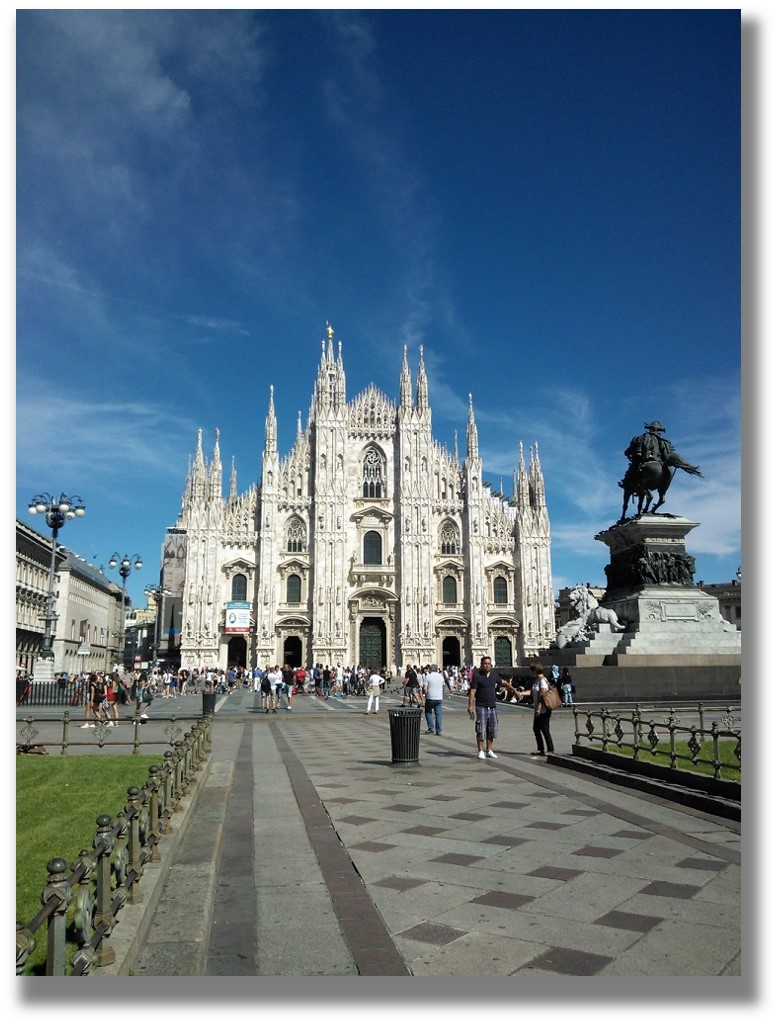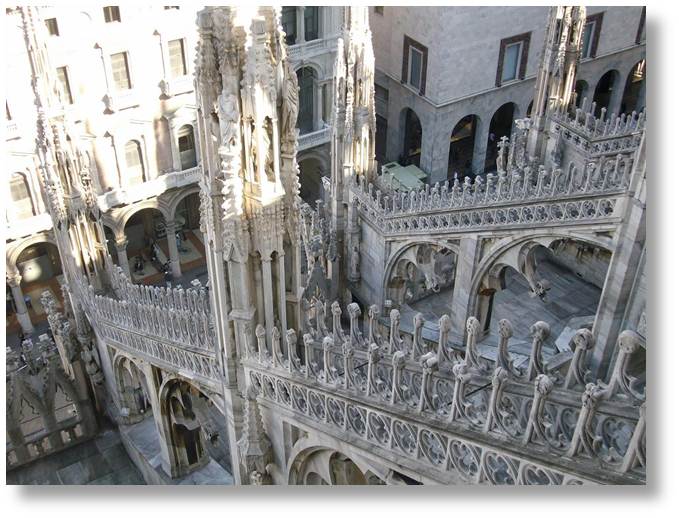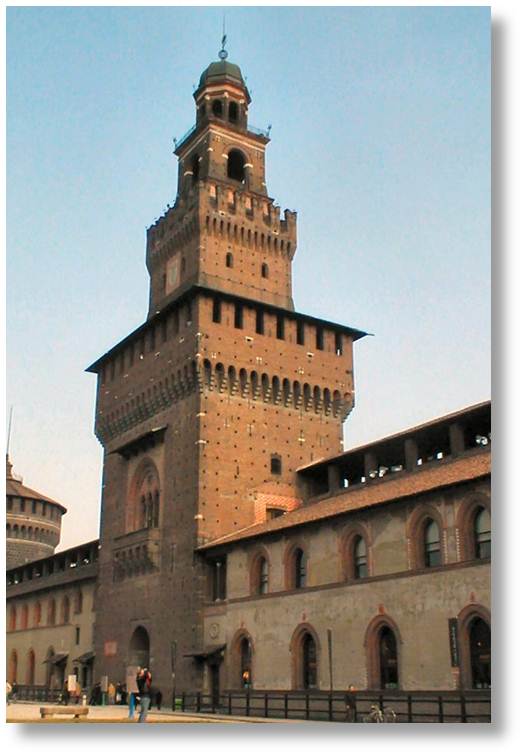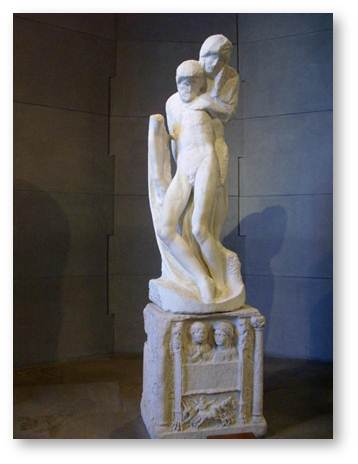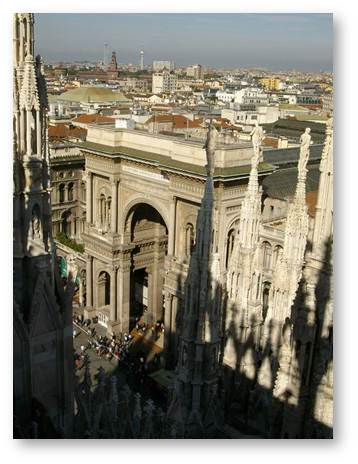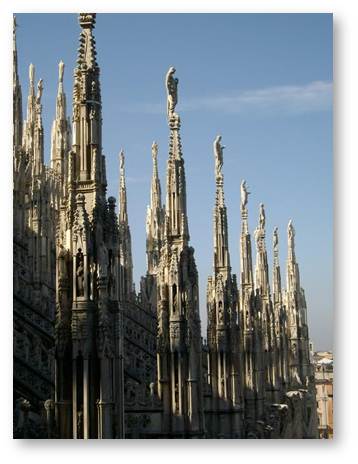|
One of the very best experiences in Milan is a trip to the Duomo's roof. You can
take the lift, or labour up the steps to the marble terraces, amidst white pinnacles and
statues. The fantastic view stretches over the city to the Alps creating an incomparable atmosphere.
|
|
The spires are crowned with statues that overlook the city. The main spire is 109 meters high.
These can all be investigated close up on a breathtaking walk on the roof.
|
|
The Sforzesco Castle, one of the most famous monuments in Milan, has seen long historical
vicissitudes in the past years. It was demolished, then rebuilt several times, embellished
and restored to become a symbol of both happy and dramatic events that are to be found in the
historical background of the city.
|
|
The Church of Santa Maria delle Grazie is one of the most striking monuments of Lombard
Renaissance. It was built between 1466 and 1490 under the direction
of Guiniforte Solari, only subsequently, in 1492 the apsidal part was added by Bramante.
The inside of the church has a double series of side chapels which highlights the Solari's Gothic
background just as the arcades on the two rows of columns. The vaults bear
frescoed decorations dating from the birth of the building, rediscovered after they had been
hidden in 600.
|
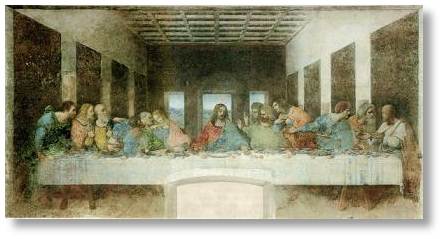

|
|
Bosco Verticale,
in the "modern Milan", wins the Highrise Award 2014, the competition that rewards the most innovative
skyscrapers in the world.
On November 19, 2014, has been assigned to this project the final award. Which is a confirmation of the excellent work
done by the architects Stefano Boeri, Gianandrea Barreca, Giovanni La Varra of Boeri Studio.
The two towers have received LEED Gold, the highest degree of energy certification. This was possible because Bosco
Verticale is a system that optimizes, recovers and produces energy. The Vertical Forest, over 1,000 plants and trees,
helps creating a microclimate and filtering is an important issue in the urban environment. The diversity and features
of plants produce humidity, absorb CO2 and dust, produce oxygen, protect the irradiation and acoustic pollution,
improving the comfort of living and saving energy. The irrigation of plants will be done to a large extent through a
centralized filtration of water.
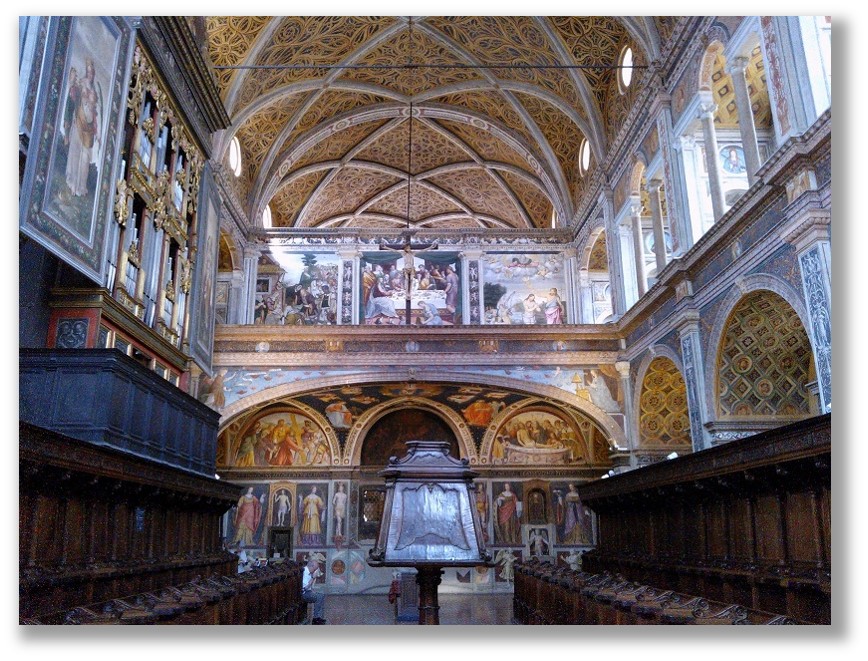
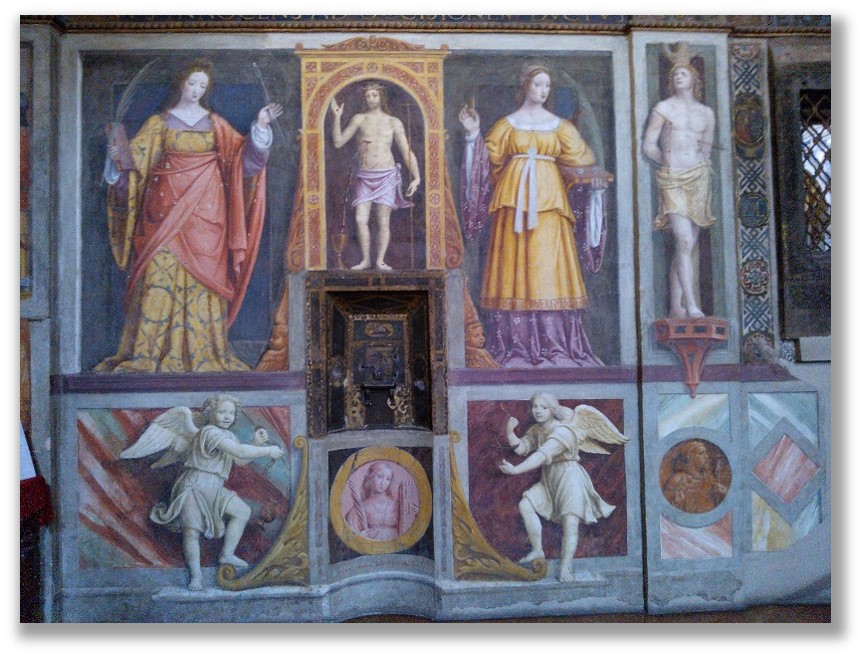
In Milan, there is a small museum housing masterpieces from some of the biggest Italian
artists. While most think of the Vatican
Museums or Uffizi Gallery as the best art museums in Italy, the lesser-known Pinacoteca di Brera is one of the best art museums in the world.
The Pinacoteca di Brera, or Brera Art Gallery, houses more than 400 works from the 14th to the 20th century by master painters such as Piero
della Francesca, Raphael, and Caravaggio.
Located in the beautiful Palazzo Brera, it was created along with the Accademia di Belle Arti, or Academy of Fine Arts, in 1776 to serve as a
font of information for the students studying at the University.
The Palazzo itself is a work of art. The Jesuits built the Baroque palace at the end of the 17th century as a convent. After they were moved
out, Palazzo Brera was remodeled in the neoclassical style.
|
copyright © 2023 Lucia De Zuani - All rights reserved - P.Iva 02329910034 - Privacy
|
|
The Duomo. It is the second cathedral in Italy by size after St Peter's in Rome. This impressive Gothic style
monument dominates the vast square where it is situated and the "Madonnina" (a statue of the
Blessed Virgin), in gilded copper, dominates the whole city.
|
|
The construction of the spires and towers were completed in the middle of the nineteenth century.
|
|
In the centre of Milan is the Renaissance Sforzesco Castle, built by Francesco Sforza
in 1450 over a previous fortress of the XIV century.
|
|
The castle hosts many museums. The most famous is the Pinacoteca, with an art
collection which includes Michelangelo's last sculpture,
the Rondanini Pietà.
The Castello complex also includes The Museum of Ancient Art, The Furniture Museum,
The Museum of Musical Instruments and the Applied Arts Collection, The Egyptian and Prehistoric
sections of the Archaeological Museum and the Achille Bertarelli Print Collection.
|
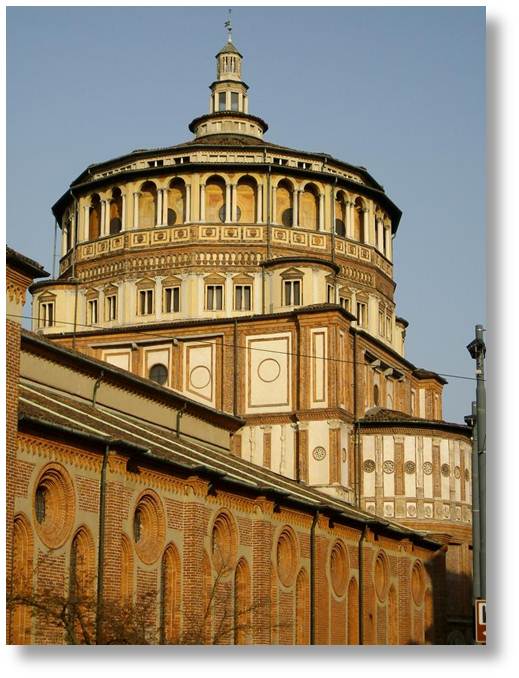
|
|
In the refectory of the Dominican convent of Santa Maria delle Grazie you will find this
great work of art that Leonardo da Vinci was commissioned to paint by Ludovico il Moro,
from 1496 to 1498.
The Last Supper
painted by Leonardo da Vinci is ingeniously devised as an expansion of
the perspective of the space in which it is set (1495-1497). It is one of the most famous
works of art in the world.
The scene portrays the moment in which Jesus tells his disciples that one of them is
about to betray him. The Last Supper is included in the UNESCO's list.
If you want to see it you need to ask me when you book your stay.
|
Leonardo and the forgotten history of a vineyard.
A forgotten story links Leonardo da Vinci to Milan - the story of a vineyard. The same vineyard that Ludovico "Il Moro" Duke of Milan, gave to Leonardo
as a gift in 1498. A vineyard surrounded by legends involving Leonardo, his works and his followers. Today the vineyard is born again, within the original
rows and with the original vine stock.

|
San Maurizio al Monastero Maggiore
is one of the most ancient churches in Milan. It is another jem of
Milanese art hidden behind a simple facade and returned to the city after 30 years of restauration, in June 2015. Walk through the door and you are overwhelmed and ravished by the frescoes that cover every inch of its walls and vaults.
Built as a monastery for cloistered nuns, it is considered the Sistine Chapel of Milan for the beauty of its frescoes, that come from the schools of the Luinis, Boltraffio, Foppa.
Those artists were real masters of the art in Lombary in the XVI century.
The place is divided in two parts: the church itself and the monastery, that used to be stricktly reserved to nuns and it is called the Hall of the Nuns.
Eight chapels, distributed on both sides, are mostly painted by the Luinis, both father Bernardino and his three sons as well
as the other masters.
The Hall of the Nuns is the real jewel where the works of the great artists astonish in succession.
|

Caravaggio, Cena in Emmaus 1606
|
|
